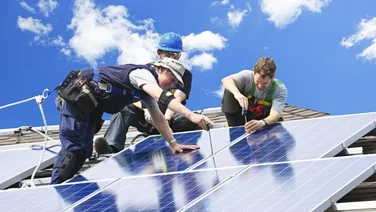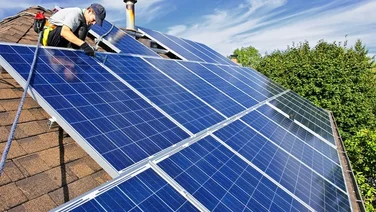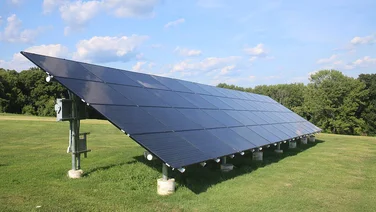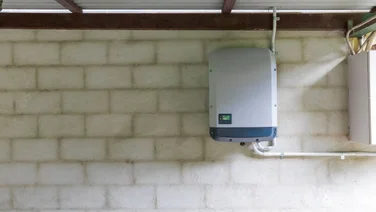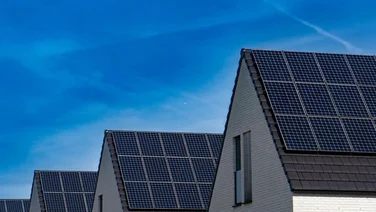- What is the Tesla Powerwall?
- What are the benefits of a Tesla Powerwall?
- How much does the Tesla Powerwall cost?
- Which Tesla Powerwall should I buy?
- Tesla Powerwall 2 vs Tesla Powerwall 3
- How often do I need to replace my Tesla Powerwall?
- Where should I mount the Tesla Powerwall?
- Can I retrofit my solar system with a Tesla Powerwall?
- Can I pay a grant to pay for a Tesla Powerwall?
- Summary
- Tesla Powerwall is designed to help store solar power at home
- The Powerwall 2 is available in the UK
- The Powerwall 3 is also ready to order in the UK
The Tesla Powerwall range is designed to help homeowners become more energy-independent. This is done by storing solar power that is generated during peak daylight hours for you to use in the evenings, during power cuts or in periods of high energy demand.
It will also help increase energy savings, reducing them as soon as it’s installed, and will act as your own private uninterruptible power supply. It can also help increase the value of your property because of these energy savings.
Recently, the Tesla Powerwall 3 became available in the UK, and in this guide, we’ll dive into its features, costs and any available grants.

What is the Tesla Powerwall?
The Tesla Powerwall is a solar battery system designed to store the energy generated by the solar panels, or solar roof tiles installed on your home.
Homeowners can use the Tesla Powerwall during the evenings, low-sunlight days or when the power grid fails. The stored energy can be used to power lights, outlets, and appliances for a few days if needed – depending on the power demand in your home.
“Powerwall’s electrical interface provides a simple connection to any home or building,” explains Tesla.
The Powerwall features a fully integrated alternating current (AC) battery system designed for residential or light commercial use.
Tesla has, to date, designed and released four variants of the Powerwall (Powerwall 1—now discontinued, Powerwall 2, Powerwall +).
Yes, you can save money with a Tesla Powerwall. While the unit helps you store and use the power you’ve generated yourself, you save money by not being charged for using electricity drawn from the power grid.
However, the money you’ll save will depend on the amount you use and the energy cost over the Powerwall’s lifetime. That said, you should typically expect a payback on your initial outlay within 3 to 5 years (as long as the units are well maintained).
What are the benefits of a Tesla Powerwall?
The Tesla Powerwall offers plenty of benefits, which include:
- Becoming more energy independent – by installing a solar battery, you’ll be less dependent on the national grid to power your home.
- Increasing your home’s value – the Powerwall can add value to your home, potentially allowing you to negotiate a higher sale price.
- Having solar energy to use during an outage – this its one of its key benefits, enabling the system to work as a handy UPS for your abode.
- Save money on electricity bills – what’s not to like?
- Not having to worry about maintenance – Tesla’s Powerwall is famed for its low-maintenance requirements, making you a handy autonomous home energy helper.
- Having an app to monitor it – there is nothing better than having everything in an app when it comes to home energy management.
- It’s weatherproof – the system is designed to be resistant to the elements, meaning it can be readily installed outside.
- It can be easily integrated as part of your solar panel system.

How much does the Tesla Powerwall cost?
At the time of writing (April 2025), a single Powerwall unit will cost £5,500, excluding VAT, installation, and other associated costs. However, you’ll also need to buy a Gateway unit to install the Powerwall unit(s). These cost £975 excluding VAT.
The Gateway unit is an essential component of the whole setup. It serves as the central communications hub for the system, connecting it to the internet and your home.
The unit provides a gateway to Tesla’s dedicated servers, enhancing the system’s ability to work as a smart, integrated energy storage and management system.
Tesla’s Gateway unit also isolates your house from the electricity grid, allowing the inverter to work safely and legally.
You can buy more than one Powerwall unit, but in the UK, this doesn’t afford any bulk savings beyond limiting associated one-off costs like the Gateway unit.
During a power outage, a single Tesla Powerwall battery can provide enough power to keep the essential parts of your home running, such as lights and outlets.
However, if you need to power bigger appliances and store more excess solar energy, you will probably need to install additional batteries.
Which Tesla Powerwall should I buy?
As of April 2025, you can buy both the Tesla Powerwall 2 and Powerwall 3. If you are genuinely on the market to get your hands on the solar battery for your home, the Powerwall 3 might be the right choice.
Use the information below, though to determine which is right for you:
Tesla Powerwall 2: Key features
The Tesla Powerwall 2 is a compact home battery system, measuring 1,150 mm in height, 753 mm in width, and a slim 147 mm in depth, weighing approximately 114 kg.
Its slender design allows for straightforward installation and minimal space usage, making it suitable for indoor and outdoor setups.
Powerwall 2’s sleek design enhances its aesthetic appeal and improves accessibility and maintenance efficiency.
Put simply, it looks cool and is fairly inconspicuous.
| Tesla Powerwall 2 basic specs | |
|---|---|
| Total capacity | 14 kWh |
| Peak power | 10kW |
| Depth of Discharge | 100% |
| Dimensions | 1,150 x 753 x 147 mm |
| Weight | 114 kgs |
| Warranty | 10 years |
Tesla Powerwall 2 vs Tesla Powerwall 3
The main differences between Powerwall 2 and Powerwall 3 can be summarised as the following:
- The Powerwall 2 is AC-coupled only – One of the main differences is the way each Powerwall unit can be attached to your home’s wiring. The Powerwall 2 is alternative current coupled only. Powerwall 3 is both AC and direct current (DC) coupled. This means the Powerwall 3 is easier to integrate with your solar panels.
- The Powerwall 3 has its own inverter – Another major difference is the fact that the Powerwall 3 has its own integrated hybrid inverter. It is this that makes the Powerwall 3 AC and DC coupled. This inverter enables Powerwall 3 to supply power directly from the solar panels on demand and store excess power in the unit’s batteries.
- The Powerwall 3 has more than double the power – The Powerwall 3 has a higher power output rating of 11.5 kW compared to the Powerwall 2’s 5 kW, allowing it to power more devices in your home simultaneously without relying on the grid.
The Tesla Powerwall 3 costs around £7,995 for the unit, and an additional up to £2,800 for installation and hardware.
For comparison, at the time of writing, units of the Tesla Powerwall 3 in the U.S cost around $9,300 (£6,978.08) for the unit and installation costs around $1,000 (£750) to $3,000 (£2,251).
How often do I need to replace my Tesla Powerwall?
Tesla Powerwall units have a lifespan of at least 10 years. This is the best case based on the units being regularly serviced and the storage batteries being replaced every five years.
If you live in an area with extreme weather – unlikely in the UK, I know – each Powerwall might have to be replaced more often. This is also the case if the Powerwall experiences frequent ‘cycling’ from full charge to empty and back again because constant recharging will wear the battery down.
Also, note that the average Tesla Powerwall can withstand 4,000 charge cycles and is considered fully charged when it reaches 80%.
Replacing a Tesla Powerwall costs about £6,500, and installation costs £800-£1,000.
- Keep it in a cool and dry place
- Don’t overcharge or overuse the battery
- Monitor your battery’s temperature regularly
- Monitor how the battery performs over time.
Where should I mount the Tesla Powerwall?
The Tesla Powerwall 2 can be installed inside your home or on an external wall exposed to weather conditions. It is water—and dust-resistant, meets IP67 standards (IP56 for the wiring compartment), and can function efficiently in temperatures as low as minus 20ºC.
Not all battery products available in the UK operate properly in sub-zero temperatures. Therefore, the Powerwall is an excellent option for outdoor installation if you have limited indoor wall space for battery storage.

Can I retrofit my solar system with a Tesla Powerwall?
Yes. Tesla Powerwall systems are designed to integrate with new and existing solar PV systems.
This is primarily because Powerwall systems are AC-coupled, making them compatible with most solar PV inverter designs. For reliable operation during power outages, a minimum of one Powerwall is required per 7.6 kW AC of solar connected to the backup circuit.
If you currently have a solar panel system and want to add a Tesla Powerwall (like the Powerwall 2), you can install it without needing other specialist gear.
However, suppose you’re installing new solar panels and don’t require specialist technology for shade mitigation or panel monitoring, such as SolarEdge power optimizers. In that case, you can connect directly to Powerwall 3’s integrated solar inverter.
This DC-coupled setup effectively mitigates shading with the integrated inverter’s six inputs. If you want advanced inverter technology like SolarEdge, you will wire up the Powerwall 3 independently from the solar panel system.
Can I pay a grant to pay for a Tesla Powerwall?
At the time of writing, no specific grants can be used to offset some of the costs of installing a Tesla Powerwall system. However, other financial incentives can indirectly help.
For example, residential solar batteries attract a 0% VAT incentive, which began in February 2024. However, this only applies when the batteries are installed alongside a new solar PV installation or as part of an existing PV install retrofit.
The Smart Export Guarantee (SEG) scheme allows you to earn money by exporting any surplus electricity generated by your solar panels and storing it in your Powerwall back to the grid. The compensation rates for this scheme can vary, so it is recommended that you contact your energy supplier to understand the potential benefits based on your specific circumstances.
The Home Energy Scotland Loan is also another option if you live north of the English border.
Check out our guide for more information about government grants for solar panels and batteries.
Summary
- Tesla Powerwall is a great option if you are looking to store excess solar PV-generated power for future use instead of selling it back to the grid.
- This helps you reduce your reliance on the national grid and will, over time, save you a pretty penny on your electricity bills. Powerwall installations also double up as your private UPS in case of power outages.
- The units are well-designed, thin, and weatherproof, meaning they can be installed easily inside or outside your home.
- The Tesla Powerwall 3 is now available for around £7,995 plus installation costs.
- While no specific grants exist, you can investigate other incentives like 0% VAT, SEG to help indirectly fund your installation.


